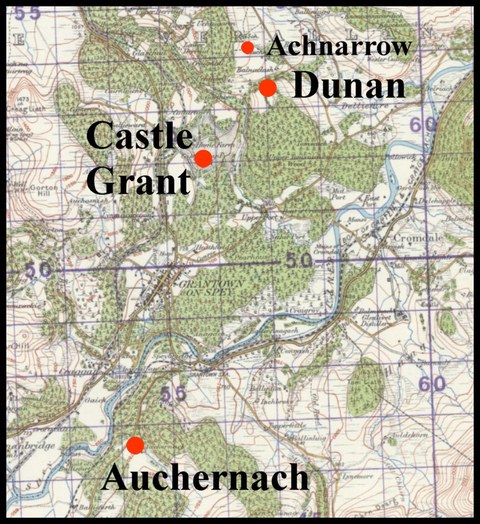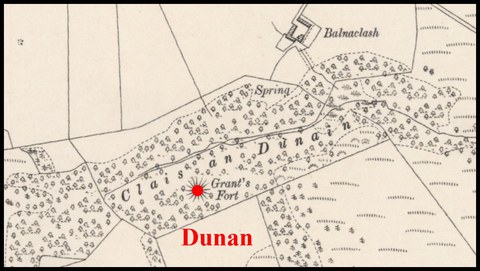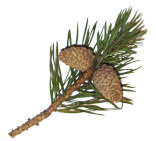NB: Help needed with this topic: see bottom of page.
The need to provide an outline of this cadet branch has been made necessary by fatuous pseudoscientific claims made in recent years in Standfast, the magazine of the Clan Grant Society (see below). However the ground had been laid by the attempts of “The Good” Sir James Grant to rewrite the origins of the clan altogether (first promulgated in 1773) which then encouraged Sir William Fraser (1883) to all but airbrush them out completely.
The real origin and early story
The “Alan” of the Clan Alan Grants was the third son of Gregory Grant, 2nd Chief. He was born at Balachernoch (now “Castle Kitchie” in the grounds of Balchuirn farm just north of the River Farigaig on Loch Ness side) around 1213. He was probably named after Alan of Tewkesbury (for full details see “Scottish Clans…” volume I).
Whereas his uncles had largely sought a future for themselves abroad, Alan and his younger brother whom MS historians have called Lucas, but whose real name was probably Moluag (associated with Balachernoch was a chapel dedicated to St Moluag) remained on the estate where they and their principal descendants peopled the land cementing Grant control.
Intervening records do not detail these descendants, but in 1420 Chief Ian Roy Grant was in the midst of the feud which the Comyns had started – and he needed reinforcements. So he asked his clansmen to abandon Stratherrick for a future in Strathspey. The representative of the Allanachs was amongst those who did just that.
Just how besieged Ian Roy felt can be seen from the map below showing Castle Grant (then known simply as Balachastel) and Dunan where the Allanach took up residence and Achnarrow where the representative of Clan Ciaran (the name given to Lucas’ descendants) went to live. Clearly they were close to the border with ‘enemy’ (in this case Comyn) territory.

Base map: maps.nls.uk
“Dunan” is shown on old maps as “Grant’s Fort” and is classified as a motte. At this stage it is not clear whether it was constructed at the time or whether (more likely) it was built at the behest of Olaf Hemingsson – clearly it is intended as a forward position defending Castle Grant from the North and as such is surely not of Comyn construction. As a motte is very unlikely indeed to predate Olaf. [See also Grant's Fort at Canmore.org.uk.]

Base map: maps.nls.uk
The word “Clais” means “ravine” and this is remarked upon on the Canmore website (above).
When he answered his Chief’s call neither of them had any idea how long the feud would last – and it did indeed last nearly another 15 years. However, when peace was secured, the Allanach was left twiddling his thumbs. Yes, he had a farm – a small estate stretching south and east from Dunan towards the Spey, but he was under layers of feudal “management” not befitting his status. So it was not long thereafter that another Alan in the line (probably the son of the man who had made the move) gained a position as Steward in Abernethy.
“Ownership of” Abernethy is not at all straightforward and was Balkanised. While the north of the parish seems to have been controlled by Moray, the lordship of the south was with the Gordons.
Fraser specifies that in 1501 King James IV granted Abernethy to his ‘natural’ son James Stewart when he made him Earl of Moray, suggesting that it had been in crown hands before that. However the earldom had been forfeit to the crown in 1455 and even if, as Fraser argues, Abernethy was not an integral part of the earldom, that does not mean that it was not “owned” by the earls whether in tack or wadset. Given that we have seen that Sir Duncan Grant obtained a crown tack of Ballindalloch (where he later installed his son Patrick) it seems likely that he did the same sort of thing for the Allanachs in Abernethy.
So Alan took up residence at Revack which he renamed Achachearnach in honour of the family’s allegiance to the Angel Victorius (as also personified in Ulster mythology as Conall Cearnach). It is now known as Auchernach (see further the paper on Revack in the Miscellany section). It is also suggested that he was castellan of Castle Roy. In later generations his family would spread out to occupy many farms first in Abernethy and then beyond to Kincardine, into Duthil (then still known as Glenchearnick) and further away when the opportunity arose.
In 1586, Duncan Grant, the then chieftain did surrender his lands to the Chief of Grant for a regrant, but given the split feudal allegiances, it should come as little surprise that he took the Gordon side in Huntly’s rebellion in 1589. But he did not suffer greatly as a result. In 1609 there was an ex cambion exchange between Huntly and the chief of Grant whereby Abernethy came under full Grant control and ‘ownership’.
The Arms of the Chieftain of the Allanachs
In 1677 another James Grant of Auchernach matriculated his arms (see Fraser (vol.I page 532)).
Grants of Auchernach, Chiefs of the Clan Allan branch of the Grants: Gules, a star argent betwixt three antique crowns, or: Crest, a burning hill: Motto, Stand sure. [Matriculated by James Grant of Auchernach, 18th June 1677.]
The Clan Chief of the day was Ludovick Grant later “The Highland King” and we can be totally confident neither that would he have approved these arms nor that the Lord Lyon of the day (Sir Charles Erskine of Cambo Bt) would have granted them had there been even the least doubt over James’ being a senior blood member of the chiefly family.
DNA Support:
Despite the lack of a current Chieftain as such (see below) there are members of this cadet branch who do have a family tree and the good news is that DNA testing has shown that they are R1a – exactly what we might expect from a Viking (the same haplogroup as the MacDonald chiefs). So science is supportive of their claim to be descendant in the male line from Olaf Hemingsson and the original Viking chiefs.
Reassignment/Disposition of the Chieftainship June 14th 1777
(Noted in Fraser Vol 1 p 532/3)
As has been seen elsewhere the whole clan system was brought to a juddering halt by the Jacobite rebellion of 1745 and its failure. In Strathspey the deconstruction was effected by the redeeming of wadsets and the selling off of other parcels. Exactly what happened to Auchernack is not clear, but on one family tree Duncan Grant, the then chieftain is described as a “tacksman only” – so it appears that one way or another the wadset was redeemed in the immediate aftermath of 1745.
Duncan had been of Jacobite persuasion, and signed the treaty of neutrality, so it appears that Chief Ludovick’s vengeance was sharp. Fraser does not even mention Auchernack in or around the relevant chapters.
Duncan died without a direct heir in 1776 so the chieftainship (which was by then no more than the right to the coat of arms) passed to his nephew Neil who promptly sold it on to Dr Gregory Grant (13: 08:1726 – 30:03:1803) of Edinburgh (a relative as a son of John Grant of Burnside). The political milieu may be gauged by the fact that Gregory was the brother of Colquhoun Grant WS who had been in Prince Charles Edward’s bodyguard.
Here is the text of the relevant deed:
At Edinburgh, the thirty-first day of December, in the year one thousand seven hundred and seventy-seven, in presence of Robert Boswell, Esquire, Lyon Depute, compeared Mr. William Richardson, one of the sollicitors before the Lyon Court, as procurator for Doctor Gregory Grant, and gave in the renunciation and conveyance afterwritten, desiring the same to be recorded in the Lyon Court Books of Scotland for preservation, which desire the said Lyon Depute finding reasonable, ordained the same to be done accordingly, and of which the tenor follows:I, Neil Grant, eldest lawful son of the deceast John Grant in Lincorn, and nephew of Duncan Grant, last of Auchernack, and therefore undoubted representative of the said family of Grant of Auchernack, and who, in consequence, have the only right to the coat armoriall peculiar to that family, do, by these presents, upon certain grave and weighty considerations, and just and onerous causes, renounce, overgive, and convey, to and in favours of Doctor Gregory Grant, physician in Edinburgh, my near relation and beloved cousine, and his heirs, my right and title to the coat of arms and ensign armoriall belonging to the said family of Grant of Auchernack, with power to the said Doctor Gregory Grant to procure the same confirmed to him and his foresaids by the Lyon King of Arms, [533] and thereafter to bear and use the same as their own proper coat armoriall; aud I bind and oblidge me and my heirs never to revock these presents, nor come in the contrary hereof any manner of way; and I consent that these presents be recorded in the Registers of the Lyon Office, therein to remain for preservation, and thereto constitute my procurators.
In witness whereof, these presents (written upon stampt paper by Ludovick Grant, Junior, writer in Edinburgh) are subscribed by me at Edinburgh, the fifth day of February one thousand seven hundred and seventy-seven years, before these witnesses : Sir James Grant of Grant, Baronet; James Colquhoun, younger of Luss, Esquire, advocate; Coll. Alexander Grant of Arndilly; James Grant, younger of Corrimony, Esquire, advocate; John Grant of Lurgg, Esquire ; and the said Ludovick Grant. (Signed),
Neil Grant. James Grant, witness; Ja. Colquhoun, witness; John Grant, witness; Lud. Grant, witness; James Grant, witness ; Alexr Grant, witness. Register of Genealogies, Lyon Office, vol. i. p. 230. Thereafter Dr. Gregory Grant matriculated his arms as follows: Gules, a star of seven points waved between three antique crowns, or: Crest, a burning hill proper: Motto, Stand sure.
Gregory Grant’s own descendants are far from clear. He seems to have married twice. There may have been a of the second marriage, Archibald, who went to Jamaica. All this would need to be investigated to see if there was a claimant to the arms amongst Gregory’s descendants.
Where the money went is not at all clear, but Neil’s own family stayed on at Mid Curr in Glen Brown (which had been Auchernack summer grazing) to 1870 when Lewis Grant died age 84. In his obituary he was described as having been recognised locally as “the last Chieftain of Clan Allan”. However this was by no means in fact the end of the line which continued through to his great grandson Lewis (b. 1900) who died unmarried in Glen Brown in 1960. This last Lewis had 8 or 9 siblings who all left the area. Failing a line from Gregory, these siblings and their descendants would still need documenting to establish whether or not it might produce a claimant.
Why the origin of this line has been disputed
On other pages we have seen how Sir William Fraser in particular “airbrushed” the origins of the Ballindalloch and Dalvey cadets by top slicing the progenitors from their pedigrees in an apparent attempt to cast a veil over what Victorians might view as indelicacy. In the case of the Grants de Vaux, in France, he gaslit them by default. Despite including their correspondence, he simply denied the narrative which established the reason they existed.
In the case here, of the Allanach or Clan Allan Grants, he had a serious problem. If he had acknowledged them and the ancestry they claimed, his “Norman Origin” narrative would have been shot to pieces. So he provided no pedigree for them at all and refers to them only obliquely at all (vol 1 introduction p lxxiii):
Among the wadsetters of Abernethy, there were several families of considerable importance, including that known as the Clan Allan, the chief of which was Auchernach. Others were Gartinmore, Tulloch, Lurg, Glenlochy, and Lettoch.
This lacuna has allowed people like Geoff Grant of the DNA project to write in Standfast (2018):
It has been determined that the Grants of Auchernach and Burnside, known as the Clan Allan, do not descend from the Chiefs. They probably aligned themselves with the Lairds of Freuchie and assumed the surname Grant before the year 1569.
Geoff’s starting problem is his phrase “the chiefs”. Of course it is the case that the DNA of the Clan Allan (Viking) cadets does not match the DNA of the current (Stewart) line of chiefs – that is what the MS histories have implied all along. But Geoff simply refuses to acknowledge that here are two separate lines of chiefs – for which he has no scientific basis at all (see also the separate page about DNA on this site). So while, for his own personal reasons, Geoff may be “determined”, the science provides no such “determination”. Not only that but, contrary to his ill-informed and entirely unscientific speculation, the Clan Allan chieftains were using the surname Grant BEFORE the current line of chiefs!
It is even more sad that the article by Geoff Grant was countersigned by James “Hank” Grant, who had written some decades ago for the US Clan Society
According to tradition, the Clan Allan descends from a younger son of an early Grant chieftain in the 13th century.
As we have seen, what Hank wrote then was correct, if a bit telegraphic. But, sadly, he is dogmatically wedded to the “Norman Origin” narrative – and the DNA proves him wrong. So, disreputably, he has had to resort to supporting Geoff’s insult.
Conclusion
Modern science vindicates the traditional Clan Allan narrative. There is no reason to doubt any element of it.
Help needed
As we have seen “we” do not know of any of the possible descendant lines.
Dr Gregory Grant (Edinburgh physician 1726 – 1797?):
Reports are mixed: Are there any descendant lines?
The main lead is an Archibald possibly born in 1766 who went to Jamaica, but for whom nothing more is known.
Lewis Grant of Mid Curr (1875 – 1949, Farmer in Mid Curr, Glen Brown).
He is reported to have had 9 or 10 children but only one son, Lewis, who stayed put, is named. Others are reported to have gone to Forres and/or Canada, but there is scope for other destinations too. Their names and dates of birth should be available on the 1911 and 1921 censuses. They should be within the memories of people living today.
Any advice gratefully received.
